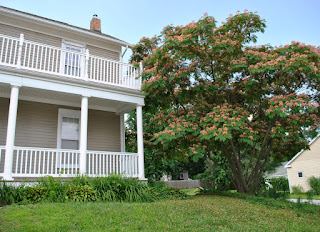Just something to consider.
A Mimosa, also called a silk tree (Albizia julibrissin), has a unique, almost tropical look. This appearance is fitting, since it thrives in warm, southern climates — it’s even heat-tolerant up to zone 10! These attractive flowering trees, like our E H Wilson Mimosa, are fast-growing and drought-tolerant. Even during intense droughts, people who have an E H Wilson Mimosa growing in their yard have been delighted by inflorescence (showy pink flower clusters) dotted along the bipinnate (fern-like) leaves of this tree.
The tree’s broad canopy, dappled with silky flowers, is a haven for bees, butterflies, and hummingbirds, which are attracted to its sweet fragrance. Plus, as an additional point of interest, the leaves fold closed in the evenings and when it rains — quite a sight to see and share with little ones!
GROWING MIMOSAS
Despite their shortcomings, southern gardeners love mimosas. They grow best with moist, well-draining, light soil, but they tolerate both clay and sand, as well as alkaline and acidic soils. They don’t grow well in salty soils, making them a marginal plant for coastal areas.
To start a mimosa, buy a potted nursery plant, if they’re available, or start it from seed yourself. Soak the seeds in water overnight. Plant them outdoors when daytime temperatures are at least 65 degrees or sow them indoors in a light potting mix. If starting indoors, plant mimosas in peat pots to avoid root disruption when you transplant them outdoors. Plant the peat pot directly in the garden.
Plant mimosas in a sunny location for best flowering and leaf color. They tolerate and thrive in hot conditions. Water newly planted mimosas frequently to keep the soil moist 1 inch beneath the surface. Established trees can tolerate drought conditions, but they’ll perform better with reasonably moist soil. Fertilize the tree every six weeks during the growing season with a ½ cup of 10-10-10 fertilizer.
Mimosas grow 15 to 30 feet tall and 10 to 15 feet wide. Plant them so air circulates freely. Avoid planting them near patios and sidewalks to prevent damage.


Comments
Post a Comment